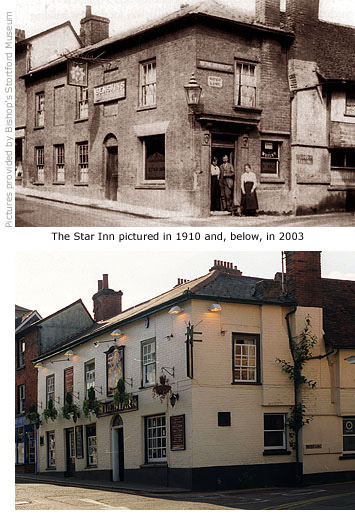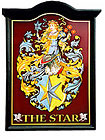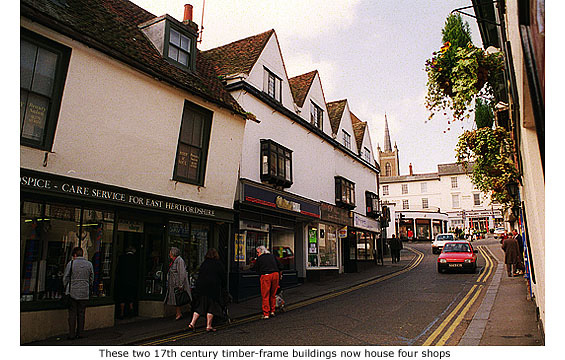|
|
|
 |
|
|
|
|
|
|
|
|
|
The Star Inn |
|
|
|
  First mention of this inn was in 1636 when it was held by one John Ward, and though the brick exterior gives it the appearance of being a much later building, they cover a timber-frame structure the foundations of which were likely to have been laid in the 16th century. Former town brewers Hawkes & Co bought the Star in 1808. First mention of this inn was in 1636 when it was held by one John Ward, and though the brick exterior gives it the appearance of being a much later building, they cover a timber-frame structure the foundations of which were likely to have been laid in the 16th century. Former town brewers Hawkes & Co bought the Star in 1808.
An entrance at the corner of the building that once opened onto Water Lane was bricked-up in the early 1900s, perhaps to protect departing patrons from potential accidents due to increased traffic. The side of the building is half covered in traditional weatherboard, while at the rear can be found the inn’s old water pump and former stables. The stable yard later became a car park but is now a small pub garden. And in the early 20th century the Star advertised accommodation for cyclists, making it particularly popular with people from local villages who would stop overnight to ensure an early start to Thursday’s market.
Former celebrated local artist, John Kynnersley Kirby (See Guide 11), a painter of many local scenes and characters in the early 1900s, once used the interior of the Star for a painting entitled ‘The Slate Club Secretary’. In it he portrayed a freelance journalist named Jimmy Sell set against the pub’s smoke-laden Victorian wallpaper.
|
|
|
|
Several shops occupy the south side of Bridge Street, all, apart from the brick building next to the Black Lion, housed in two 17th century timber-frame buildings. The upper floor of the smallest of these buildings still leans precariously into the street as it did when first built and, inside, its original timber framework is now fully exposed, as is the fireplace at the rear of the shop that is almost certainly original.
The larger building alongside it houses three shops and is two and a half-storeys high; the half-storey being added in the mid – late 17th century to accommodate attic rooms. There are four gables and three first floor bay windows, although the bays were not part of the original construction. Of the three shops beneath the most interesting unfortunately closed for business in July 2009, becoming yet another subject of Stortford's rich history. Locals will fondly recall the name of the shop, G.H. Wilson’s ‘Specialist Confectioners and Tobacconist’, many remembering their childhood years buying sweets from glass jars and a bag of penny treats from within. And for those men who enjoyed a good cigar, a glass cabinet on the counter displayed the finest and most varied selection available in the town.
George Wilson established his first shop in 1926, when he arrived here from Derbyshire and bought a former kiosk that stood alongside the old Empire cinema in South Street. Up until 1915, when the Empire closed, the kiosk sold sweets and cigarettes to cinema goers. (See Guide 15 - Cinemas). George continued there until the early 1970s, when both the former cinema and kiosk were finally demolished to make way for a new Tesco store. He then moved to these premises in Bridge Street.
George Wilson is perhaps best remembered in the town for the part he played in the successes of the town's football club. After joining the supporters club shortly after arriving here he became a committee member in 1927, later president and in the 1940s, chairman. He was the man most responsible for Bishop's Stortford FC rising from local league football in the 1920s to become one of the top non-league clubs in the country during the 1970s. His greatest honour, however, came in 1970 when the club showed its gratitude by renaming the Rhodes Avenue ground, George Wilson Stadium (See Guide 12 - Rhodes Avenue). George died in 1982, aged 90.
When the shop changed hands in 1997 its new owners knew the benefit of keeping an established and trusted name above the shop and continued selling sweets and tobacco. Unfortunately, though, times change and businesses die. In 2009 the lease was suspended by the owner of the property, the bailiffs were called in and the name G.N. Wilson became yet another fond memory. MORE PICTURES

|
|
|
|
|
|
|
|
Mary Tudor was the first born daughter of Henry VIII who, having argued with the Pope over his refusal to grant him a divorce from Catherine of Aragon, broke all ties with Rome and the Catholic faith and declared himself Supreme Head of the Church of England.
When he died in 1547 his son, Edward VI, took the throne but within six years he also died and was eventually succeeded by his half-sister, Mary. A devout catholic, she set about restoring Catholicism by sweeping away Edward's reforms and reinstating bishops of that faith who then proceeded to destroy the 'heresy' of Protestantism. The five years of Mary's reign brought about the bitterest religious persecutions England has ever known and, for good reason, earned her the nickname Bloody Mary. More than 300 protestant men and women were burnt alive at the stake for their beliefs.
A story handed down over the years has it that Bishop Bonner condemned a man named John Denley to be burned at the stake on Goosemead Green (Causeway) in 1555. In truth, Denley was executed that year, but at Uxbridge not Bishop's Stortford.
|
|
|
|
|
|
|
[ BACK TO TOP ] |
|
|
|
|
|
|
|




 First mention of this inn was in 1636 when it was held by one John Ward, and though the brick exterior gives it the appearance of being a much later building, they cover a timber-frame structure the foundations of which were likely to have been laid in the 16th century. Former town brewers Hawkes & Co bought the Star in 1808.
First mention of this inn was in 1636 when it was held by one John Ward, and though the brick exterior gives it the appearance of being a much later building, they cover a timber-frame structure the foundations of which were likely to have been laid in the 16th century. Former town brewers Hawkes & Co bought the Star in 1808.